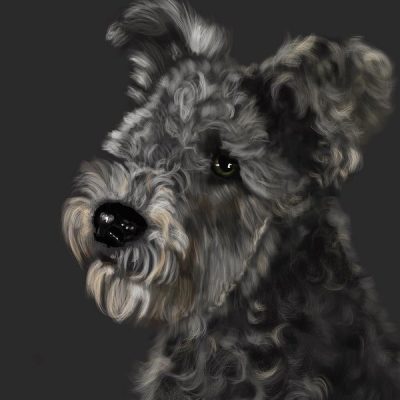
The Pumi has sometimes been referred to as the “Hungarian Herding Terrier,” a moniker that may have come from a few breed traits thought to be “terrier-like,” but barking, a quick mind, agile movement, an intensity of alertness, and a lean body are also attributes found in many herding breeds. The term also could be sourced to Dr. Emil Raitsits (1882-1934), a leading Hungarian expert who called the Pumi “the sheep dog terrier,” and pointed out that breeding the Pumi should preserve all the outstanding useful features of the terrier blood. That leads us to the opinion of experts who maintain that the breed emerged from cross breeding German Spitz, the Pomeranian Schafpudel (or Sheep Poodle), the Hajciarik, the Puli, possibly the Mudi, and an unspecified terrier.
Another name for the breed – this one a nickname – is “the clown,” probably because of those magnificent ears on which a small tuft adds particular comedy. Make no mistake, however, Pumik are serious workers who traditionally gathered, drove and kept temperamental Hungarian Grey Cattle or Racka sheep under control. Feistiness in the field can lead to a Pumi to snap at sheep legs much like a heeler, and most are masters at dispatching small vermin. This is a quick, brave, and spirited dog that can make appropriate and decisive decisions independent of the need for direction. A strong desire to please, however, makes the Pumi a quick learner who will take clear instructions.
The image of “Pearl,” (Ch Vidam Kertesz Gyongy CM2 NW3-Elite owned by Tom Levy) is by Victoria Newton and available as a print, poster, pillow, pouch and more here.

Great!. I’m so excited to be a part of the Pumi! Thanks, for the article, Best Regards, Lani and Tom
There are many errors in this article. The author obviously hasn’t researched the origins of the Pumi sufficiently or is confusing some of the information. The term”herding Terrier” is a literal translation that is causing a lot of confusion, of is a unique Hungarian contraction, which merely alludes to a “herding dog with some Terrier-like attributes”. These attributes are some aspects of temperament and square body proportions, which are shared by several other, relatively small bodied herding dogs.
We wrote a composite of the breed as seen from different sources including the Pumi Club of America website, “Dogs of Hungary,” by Pal Sarkany and Imre Ocsag, and yourself: “The Pumi has some terrier-like attributes (although there is no terrier blood in the Pumi), such as quick, alert, inquisitive temperament and a square, lean and muscular body type with a longer, narrower head than the Puli.” As Hungarians, ourselves, we have no interest in mischaracterizing the breed and your comment is welcomed.
Thank You Meir !
Correct.